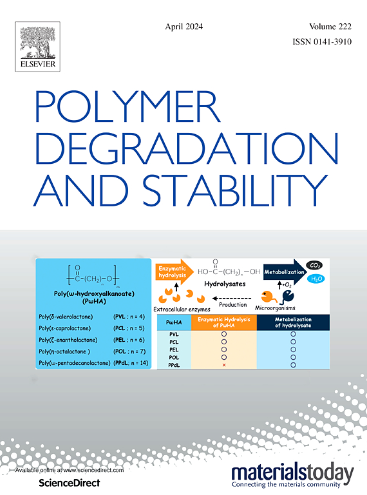氯化海水中使用的聚乙烯抗氧化剂损耗:从加速老化到建模
IF 7.4
2区 化学
Q1 POLYMER SCIENCE
引用次数: 0
摘要
本研究的重点是聚乙烯(PE)配方中使用的稳定剂暴露于氯化海水中的损失。一个含有抗氧化剂的PE模型在三种不同的环境中老化:脱氧水、脱氧水和含氧氯化海水。为了阐明缓慢发生的现象,在一系列氯浓度和温度下进行了加速老化实验。此外,还对不同厚度的样品进行了老化试验,以区分表面过程、基于反应的机制和涉及扩散的机制。在所有情况下,稳定剂的损失都是通过测量氧化诱导时间来监测的。结果表明,稳定剂的物理提取(浸出)可以用文献中已有的理论来描述,提取常数是通过在60、80和90°C的脱氧水中进行试验确定的。看来,随着时间的推移,水中氧气的存在会导致稳定剂更快地减少,这可以用这些分子与氧化过程中形成的自由基的反应来解释。在40、60、80和90℃下测定了与该过程相关的动力学速率。最后,首次确定了在21°C下两种促氧化剂浓度下氯化海水中稳定剂损失的动力学。基于文献的理论考虑,提出了稳定剂损失的动力学模型来描述本研究的结果。本文章由计算机程序翻译,如有差异,请以英文原文为准。
Antioxidant depletion in polyethylene used in chlorinated seawater: from accelerated ageing to modelling
This study focuses on the loss of stabilizers used in polyethylene (PE) formulations exposed to chlorinated seawater. A PE model containing antioxidants is aged in three different environments: deoxygenated water, oxygenated water and chlorinated seawater with oxygen. To elucidate slow-occurring phenomena, accelerated ageing experiments were performed across a range of chlorine concentrations and temperatures. Additionally, ageing tests are performed on samples of different thicknesses to distinguish between surface processes, reaction-based mechanisms and diffusion-involved mechanisms. In all cases, the loss of stabilizers is monitored by measuring the oxidation induction time. The results show that the physical extraction of stabilizers (leaching) can be described using existing theories from the literature, with the extraction constants identified based on tests in deoxygenated water at 60, 80 and 90 °C. It appears that the presence of oxygen in water leads to a faster decrease in stabilizers over time, explained by the reaction of these molecules with free radicals formed during the oxidation process. Kinetic rates associated with this process were determined at 40, 60, 80 and 90 °C. Finally, for the first time, the kinetics of stabilizer loss in chlorinated seawater are identified for two pro-oxidant concentrations at 21 °C. Based on theoretical considerations from the literature, a kinetic model of stabilizer loss is proposed to describe the results obtained in this study.
求助全文
通过发布文献求助,成功后即可免费获取论文全文。
去求助
来源期刊

Polymer Degradation and Stability
化学-高分子科学
CiteScore
10.10
自引率
10.20%
发文量
325
审稿时长
23 days
期刊介绍:
Polymer Degradation and Stability deals with the degradation reactions and their control which are a major preoccupation of practitioners of the many and diverse aspects of modern polymer technology.
Deteriorative reactions occur during processing, when polymers are subjected to heat, oxygen and mechanical stress, and during the useful life of the materials when oxygen and sunlight are the most important degradative agencies. In more specialised applications, degradation may be induced by high energy radiation, ozone, atmospheric pollutants, mechanical stress, biological action, hydrolysis and many other influences. The mechanisms of these reactions and stabilisation processes must be understood if the technology and application of polymers are to continue to advance. The reporting of investigations of this kind is therefore a major function of this journal.
However there are also new developments in polymer technology in which degradation processes find positive applications. For example, photodegradable plastics are now available, the recycling of polymeric products will become increasingly important, degradation and combustion studies are involved in the definition of the fire hazards which are associated with polymeric materials and the microelectronics industry is vitally dependent upon polymer degradation in the manufacture of its circuitry. Polymer properties may also be improved by processes like curing and grafting, the chemistry of which can be closely related to that which causes physical deterioration in other circumstances.
 求助内容:
求助内容: 应助结果提醒方式:
应助结果提醒方式:


